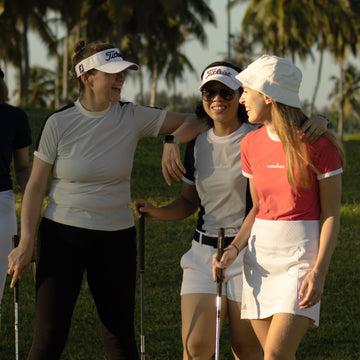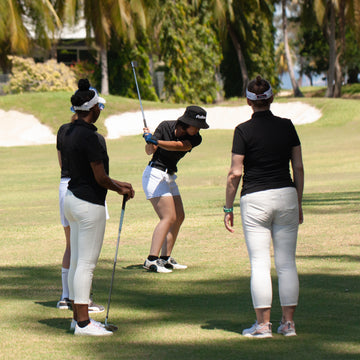
Image from NCAA
Playing golf is enjoyable but nevertheless daunting for the beginner golfer. Reportedly, you can walk up to an average distance of 6.5 miles, or at the least take a minimum of 4,000 steps on a typical 18-hole golf course - whew!
Incorporating regular exercise can help you build endurance to walk the pitch, whilst the added perks of flexibility, strength, and balance can further improve your game and prevent unwanted injuries. Beginner women golfers, in particular, should focus on exercises that also considers their physical and physiological health.
Follow along as we explore six golf fitness exercises effective at improving the golf performance of beginner women golfers.. Let's get started.
Here’s Why You Need to Be Fit in Golf
Fitness plays a crucial role in golf, and unlike popular opinion, is not just about looking good on the course. Golf recruits major muscle groups located in the core, back, and legs; the same muscle groups are involved in exercise and need conditioning to function properly.
When you're fit, you have better balance, stability, dexterity, and coordination - all essential for a successful golf swing. Additionally, a strong and flexible body enables you to generate more power and distance with your shots.
One of the lesser-known benefits of incorporating fitness into your golf routine is injury prevention. Golf involves repetitive motions that can strain muscles and joints, so, by strengthening your muscles and improving flexibility, you can reduce the risk of common golf injuries such as golfer's elbow, thumb arthritis, and lower back pain.
Stretching and Warm-up Exercises
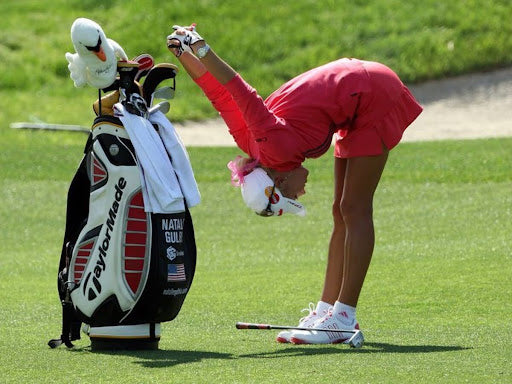
Image from ESPN
Before hitting the golf course for your practice session, start off with some warm up exercises, to wake your muscles up and prepare your body for the physical demands of the game.
You can try these two stretches in succession:
-
The wrist stretch: Extend one arm in front of you, palm facing down. Use your other hand to gently pull back the fingers of your extended arm, feeling a stretch in your wrist and forearm. Hold for 15-20 seconds and repeat on the other side.
-
The shoulder stretch: Stand with your feet shoulder-width apart and extend one arm across your chest. Use your other arm to gently pull the extended arm towards your chest, feeling a stretch in your shoulder. Hold for 15-20 seconds and repeat on the other side.
Beginner Workouts
Help yourself build and maintain a strong fitness foundation - it doesn’t matter whether you’re new to golf or otherwise. These beginner-friendly exercises strengthen and tone the same muscles that you’ll be using in golf.
Plank

Image from Getty Images via Sports Medicine
One of the best exercises all-round and for beginners is the plank, which works your core muscles. Start by getting into a push-up position, with your elbows directly under your shoulders. Hold this position for 30 seconds to start, gradually increasing the duration as you get stronger.
Plank exercises and any plank variation like side planks targets your core muscles and obliques and those in your back, which play a latent but crucial role in your balance and overall stability.
Hip-hinge
The basic hip hinge is a no-equipment beginner exercise. Simply stand with your feet shoulder-width apart, knees slightly bent, then hinge forward at your hips, keeping your back straight, until your upper body is parallel to the ground. Make sure to engage your glutes and hamstrings by clenching them, to return to the starting position. Repeat this exercise for 10-12 repetitions.
This second exercise helps improve your posture and strengthens the muscles in your lower back and glutes. Avoid dipping your hips, which dips your lower back in turn, causing lower back pain.
Single-leg balance

Image from Samarphan Physio Clinic
To improve your balance and stability, try the single-leg balance exercise. Stand on one leg, with the same knee slightly bent. Hold this position for 30 seconds, then switch to the other leg. As you get more comfortable, challenge yourself by closing your eyes or performing small knee bends, all while maintaining your balance.
You can always grab the back of a chair to steady yourself if this move feels wonky.
Squat with rotation

Image from FitOnApp
In this type of squat, you’ll be targeting lower body strength and core stability - this helps in tandem to support and propel your body.
Start by standing with your feet shoulder-width apart. Lower your body into a squat position, keeping your weight in your heels. As you rise back up, rotate your torso to the right, reaching your right arm towards the ceiling. Repeat on the left side.
Lunge with twist
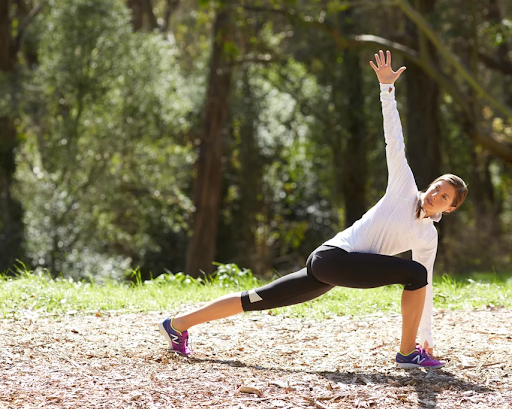
Image from PopSugar
For the legs, glutes, and core, lunge variations are your best friend. First stand tall with your feet hip-width apart. Then, take a step forward with your right foot, lowering your body into a lunge position. As you lunge, twist your torso to the right, reaching your right arm across your body. Return to the starting position and repeat on the left side.
Standing trunk rotation
Keep your firmly to the ground, shoulder-width apart, and hold a golf club or broomstick behind your shoulders. Take turns to rotate your torso to the right, then to the left - avoid turning with your hips and lower body.
Standing rotations from your trunk improves rotational mobility and helps with generating power in your swing.
Assisted Training Exercises
Strength training in golf helps build muscle strength and power, allowing you to generate more force with your swings. Usually, some form of equipment or tool is used to add resistance to strength training exercises - these two are most suited to golfers, as they help with functional and rotational strength.
The kettlebell swing: Great for improving hip and core strength, is a major technique that can help you secure a powerful golf swing.
Start with a minimum-weight kettlebell between your legs, held slightly in front of you. Now, bend at your hips and knees whilst grabbing the kettlebell with both hands. Swing the kettlebell back between your legs, then thrust your hips forward, using the momentum to swing the kettlebell up to shoulder height. Repeat for 10-12 repetitions.

Image from GoodRx
You can also try the medicine ball woodchopper - this one mimics the rotational movement of a golf swing.
Stand with your feet shoulder-width apart, holding a medicine ball with both hands. Rotate your torso to one side, bringing the medicine ball down towards your front foot. Rotate back to the starting position by engaging your core, lifting the medicine ball diagonally across your body. Repeat on the other side for 10-12 repetitions.
Golf Fitness Tips
To maximize the benefits of your golf beginner fitness routine, here are a few tips to keep in mind:
-
Start slowly and gradually increase the intensity and duration of your workouts. It's important to listen to your body and avoid overexertion.
-
Consistency is key. Try to incorporate golf fitness exercises into your routine at least 2-3 times per week for optimal results.
-
Focus on proper form and technique. Performing exercises correctly ensures that you're targeting the right muscles and minimizing the risk of injury.
-
Don't forget to stretch after your workouts. Stretching helps improve flexibility and prevents muscle soreness.
If you’d prefer expert guidance, consult with a golf fitness professional or a certified personal trainer who specializes in golf fitness. They can assess and create a fitness program with targeted exercises just for you.
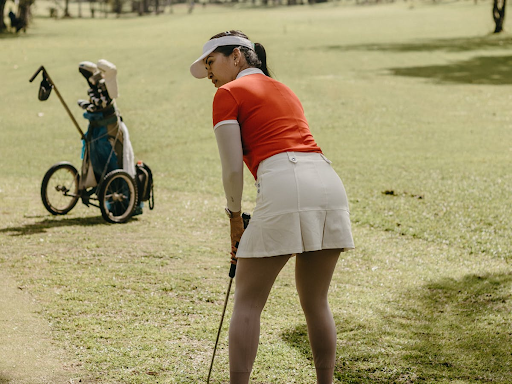
Image from Kawê Rodrigues on Pexels
It’s likely to feel the surge of confidence from playing a good golf game - a solid golf fitness routine can help you with that, and additionally ensure you have a safer experience while on the course.
The passionate golfer should make it a habit to work on their golf fitness at least a few times a week, regardless of skill level. These tips can guide beginner women golfers who are looking to improve their performance and perfect their swing, or just to maintain overall good health for attending golf practice.
Don’t dally, work on that core with some resistance bands or a stability ball. In time, your body and your golf game will thank you.




